2012 Hyundai Sonata child lock
[x] Cancel search: child lockPage 85 of 411
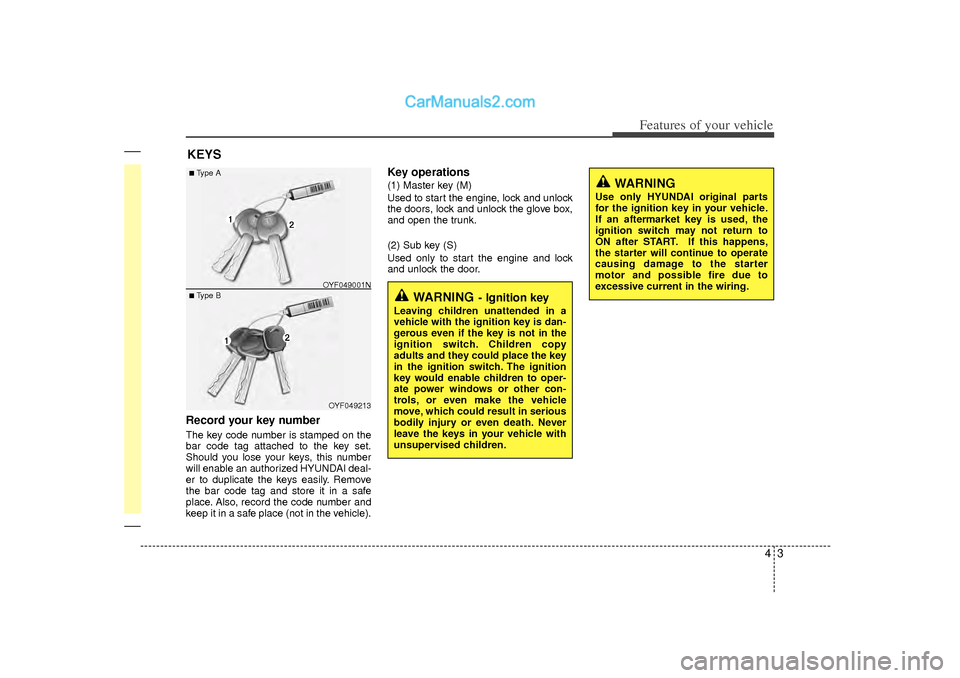
43
Features of your vehicle
Record your key numberThe key code number is stamped on the
bar code tag attached to the key set.
Should you lose your keys, this number
will enable an authorized HYUNDAI deal-
er to duplicate the keys easily. Remove
the bar code tag and store it in a safe
place. Also, record the code number and
keep it in a safe place (not in the vehicle).
Key operations(1) Master key (M)
Used to start the engine, lock and unlock
the doors, lock and unlock the glove box,
and open the trunk.
(2) Sub key (S)
Used only to start the engine and lock
and unlock the door.
KEYS
WARNING
- Ignition key
Leaving children unattended in a
vehicle with the ignition key is dan-
gerous even if the key is not in the
ignition switch. Children copy
adults and they could place the key
in the ignition switch. The ignition
key would enable children to oper-
ate power windows or other con-
trols, or even make the vehicle
move, which could result in serious
bodily injury or even death. Never
leave the keys in your vehicle with
unsupervised children.
WARNING
Use only HYUNDAI original parts
for the ignition key in your vehicle.
If an aftermarket key is used, the
ignition switch may not return to
ON after START. If this happens,
the starter will continue to operate
causing damage to the starter
motor and possible fire due to
excessive current in the wiring.
OYF049001N
■Type A■Type B
OYF049213
Page 102 of 411
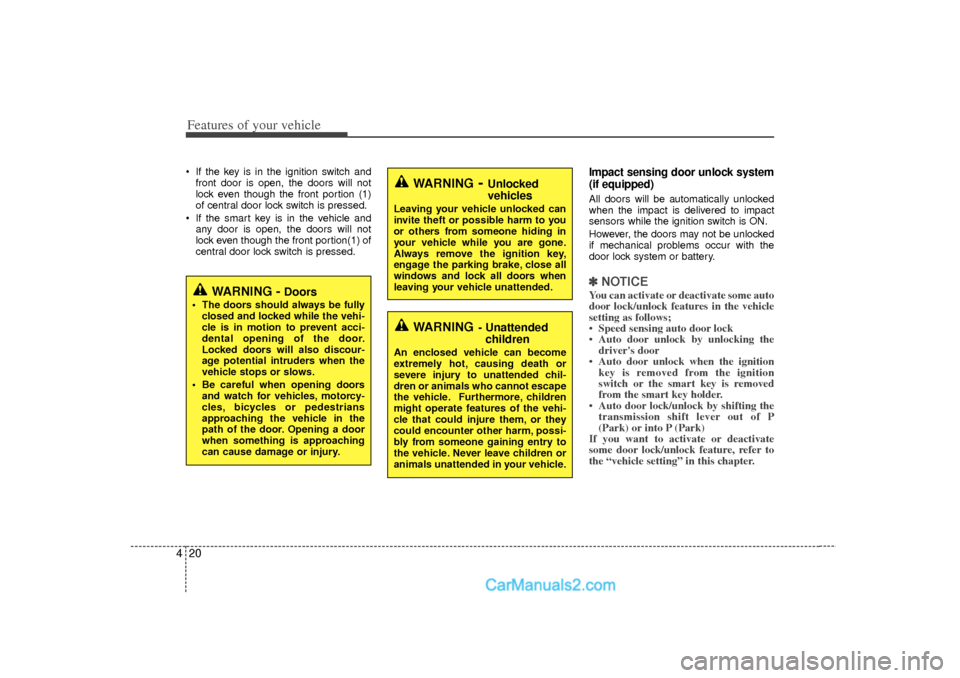
Features of your vehicle20
4 If the key is in the ignition switch and
front door is open, the doors will not
lock even though the front portion (1)
of central door lock switch is pressed.
If the smart key is in the vehicle and any door is open, the doors will not
lock even though the front portion(1) of
central door lock switch is pressed.
Impact sensing door unlock system
(if equipped)All doors will be automatically unlocked
when the impact is delivered to impact
sensors while the ignition switch is ON.
However, the doors may not be unlocked
if mechanical problems occur with the
door lock system or battery.✽ ✽ NOTICEYou can activate or deactivate some auto
door lock/unlock features in the vehicle
setting as follows;
• Speed sensing auto door lock
• Auto door unlock by unlocking the
driver's door
• Auto door unlock when the ignition key is removed from the ignition
switch or the smart key is removed
from the smart key holder.
• Auto door lock/unlock by shifting the transmission shift lever out of P
(Park) or into P (Park)
If you want to activate or deactivate
some door lock/unlock feature, refer to
the “vehicle setting” in this chapter.
WARNING
- Unlocked
vehicles
Leaving your vehicle unlocked can
invite theft or possible harm to you
or others from someone hiding in
your vehicle while you are gone.
Always remove the ignition key,
engage the parking brake, close all
windows and lock all doors when
leaving your vehicle unattended.
WARNING
- Unattended
children
An enclosed vehicle can become
extremely hot, causing death or
severe injury to unattended chil-
dren or animals who cannot escape
the vehicle. Furthermore, children
might operate features of the vehi-
cle that could injure them, or they
could encounter other harm, possi-
bly from someone gaining entry to
the vehicle. Never leave children or
animals unattended in your vehicle.
WARNING -
Doors
The doors should always be fully
closed and locked while the vehi-
cle is in motion to prevent acci-
dental opening of the door.
Locked doors will also discour-
age potential intruders when the
vehicle stops or slows.
Be careful when opening doors and watch for vehicles, motorcy-
cles, bicycles or pedestrians
approaching the vehicle in the
path of the door. Opening a door
when something is approaching
can cause damage or injury.
Page 103 of 411
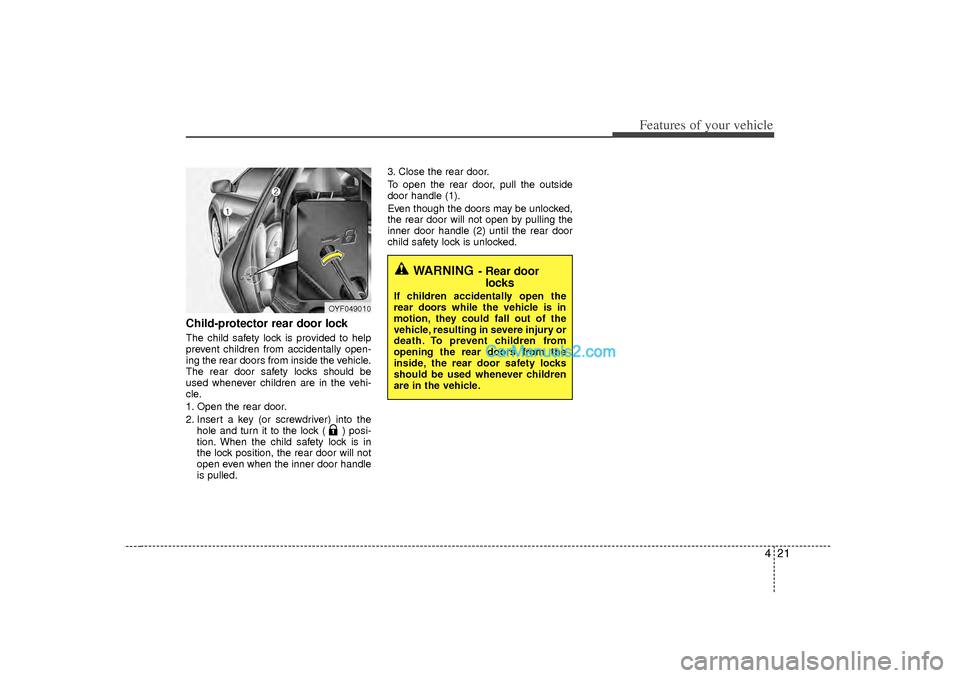
421
Features of your vehicle
Child-protector rear door lockThe child safety lock is provided to help
prevent children from accidentally open-
ing the rear doors from inside the vehicle.
The rear door safety locks should be
used whenever children are in the vehi-
cle.
1. Open the rear door.
2. Insert a key (or screwdriver) into thehole and turn it to the lock ( ) posi-
tion. When the child safety lock is in
the lock position, the rear door will not
open even when the inner door handle
is pulled. 3. Close the rear door.
To open the rear door, pull the outside
door handle (1).
Even though the doors may be unlocked,
the rear door will not open by pulling the
inner door handle (2) until the rear door
child safety lock is unlocked.
OYF049010
WARNING
- Rear door
locks
If children accidentally open the
rear doors while the vehicle is in
motion, they could fall out of the
vehicle, resulting in severe injury or
death. To prevent children from
opening the rear doors from the
inside, the rear door safety locks
should be used whenever children
are in the vehicle.
Page 105 of 411
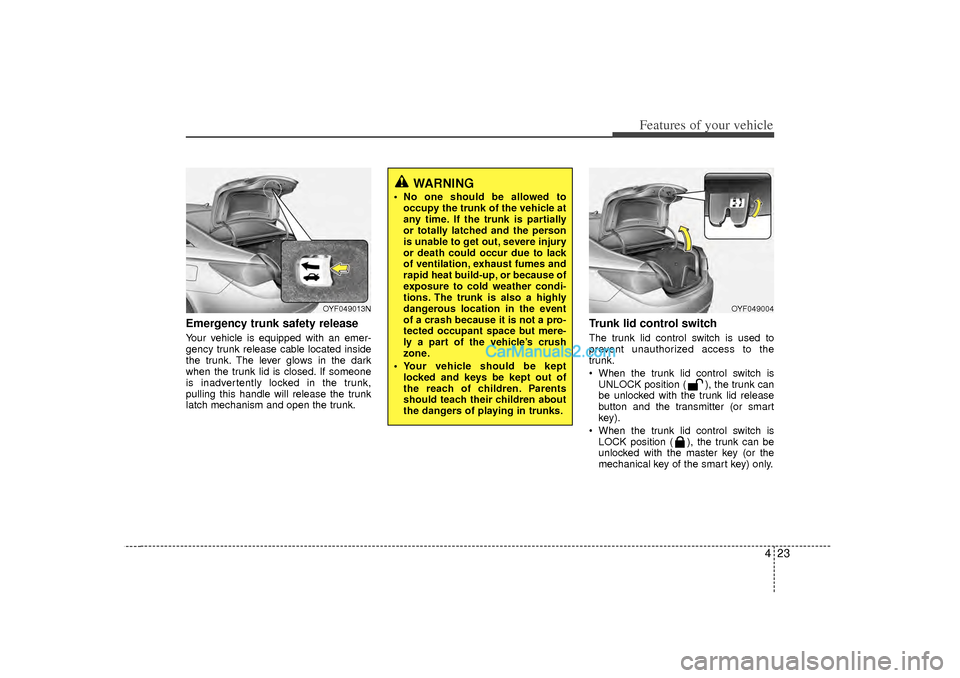
423
Features of your vehicle
Emergency trunk safety releaseYour vehicle is equipped with an emer-
gency trunk release cable located inside
the trunk. The lever glows in the dark
when the trunk lid is closed. If someone
is inadvertently locked in the trunk,
pulling this handle will release the trunk
latch mechanism and open the trunk.
Trunk lid control switchThe trunk lid control switch is used to
prevent unauthorized access to the
trunk.
When the trunk lid control switch isUNLOCK position ( ), the trunk can
be unlocked with the trunk lid release
button and the transmitter (or smart
key).
When the trunk lid control switch is LOCK position ( ), the trunk can be
unlocked with the master key (or the
mechanical key of the smart key) only.
OYF049013N
WARNING
No one should be allowed tooccupy the trunk of the vehicle at
any time. If the trunk is partially
or totally latched and the person
is unable to get out, severe injury
or death could occur due to lack
of ventilation, exhaust fumes and
rapid heat build-up, or because of
exposure to cold weather condi-
tions. The trunk is also a highly
dangerous location in the event
of a crash because it is not a pro-
tected occupant space but mere-
ly a part of the vehicle’s crush
zone.
Your vehicle should be kept locked and keys be kept out of
the reach of children. Parents
should teach their children about
the dangers of playing in trunks.
OYF049004
Page 109 of 411
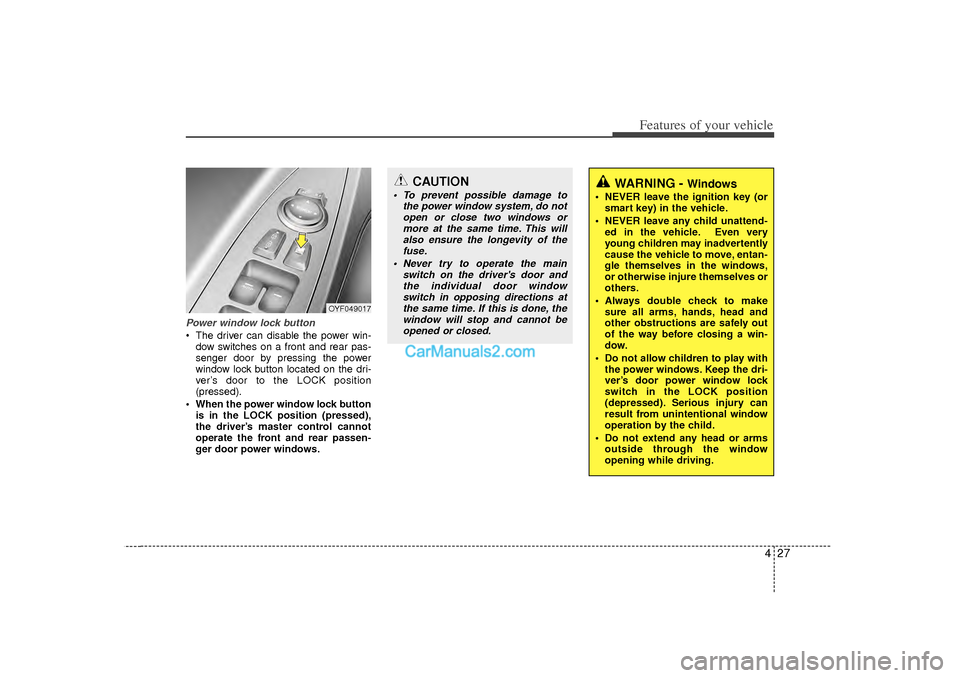
427
Features of your vehicle
Power window lock button The driver can disable the power win-dow switches on a front and rear pas-
senger door by pressing the power
window lock button located on the dri-
ver’s door to the LOCK position
(pressed).
When the power window lock button is in the LOCK position (pressed),
the driver’s master control cannot
operate the front and rear passen-
ger door power windows.
OYF049017
CAUTION
To prevent possible damage to the power window system, do notopen or close two windows or more at the same time. This willalso ensure the longevity of thefuse.
Never try to operate the main switch on the driver's door andthe individual door window switch in opposing directions atthe same time. If this is done, the window will stop and cannot beopened or closed.
WARNING -
Windows
NEVER leave the ignition key (or smart key) in the vehicle.
NEVER leave any child unattend- ed in the vehicle. Even very
young children may inadvertently
cause the vehicle to move, entan-
gle themselves in the windows,
or otherwise injure themselves or
others.
Always double check to make sure all arms, hands, head and
other obstructions are safely out
of the way before closing a win-
dow.
Do not allow children to play with the power windows. Keep the dri-
ver’s door power window lock
switch in the LOCK position
(depressed). Serious injury can
result from unintentional window
operation by the child.
Do not extend any head or arms outside through the window
opening while driving.
Page 258 of 411
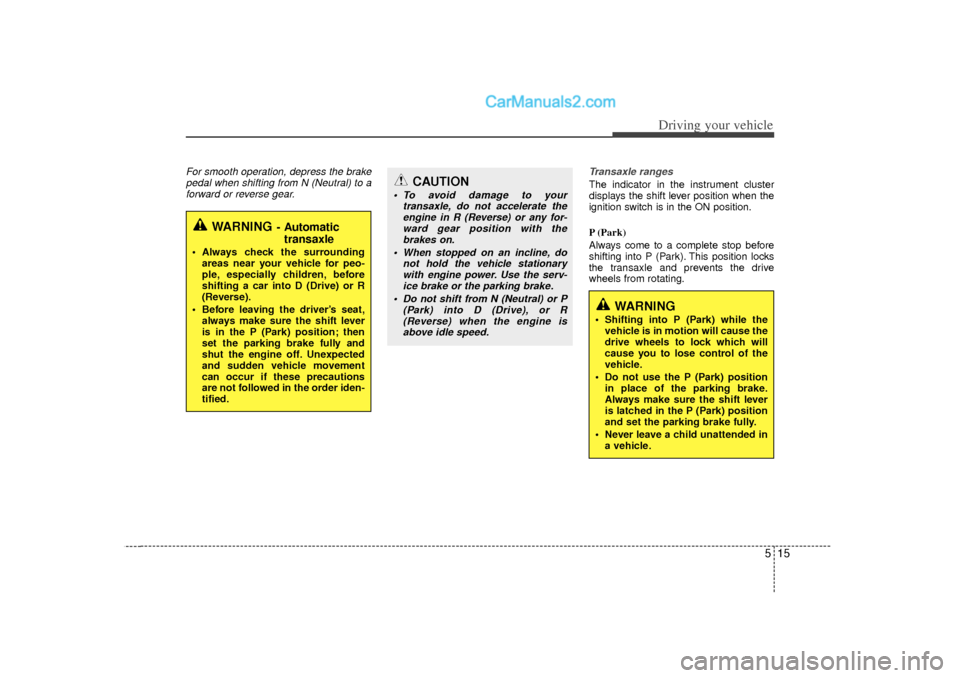
515
Driving your vehicle
For smooth operation, depress the brakepedal when shifting from N (Neutral) to aforward or reverse gear. Transaxle ranges
The indicator in the instrument cluster
displays the shift lever position when the
ignition switch is in the ON position.
P (Park)
Always come to a complete stop before
shifting into P (Park). This position locks
the transaxle and prevents the drive
wheels from rotating.
WARNING
- Automatic
transaxle
Always check the surrounding
areas near your vehicle for peo-
ple, especially children, before
shifting a car into D (Drive) or R
(Reverse).
Before leaving the driver’s seat, always make sure the shift lever
is in the P (Park) position; then
set the parking brake fully and
shut the engine off. Unexpected
and sudden vehicle movement
can occur if these precautions
are not followed in the order iden-
tified.
CAUTION
To avoid damage to your transaxle, do not accelerate theengine in R (Reverse) or any for-ward gear position with thebrakes on.
When stopped on an incline, do not hold the vehicle stationarywith engine power. Use the serv- ice brake or the parking brake.
Do not shift from N (Neutral) or P (Park) into D (Drive), or R(Reverse) when the engine isabove idle speed.
WARNING
Shifting into P (Park) while the vehicle is in motion will cause the
drive wheels to lock which will
cause you to lose control of the
vehicle.
Do not use the P (Park) position in place of the parking brake.
Always make sure the shift lever
is latched in the P (Park) position
and set the parking brake fully.
Never leave a child unattended in a vehicle.
Page 308 of 411
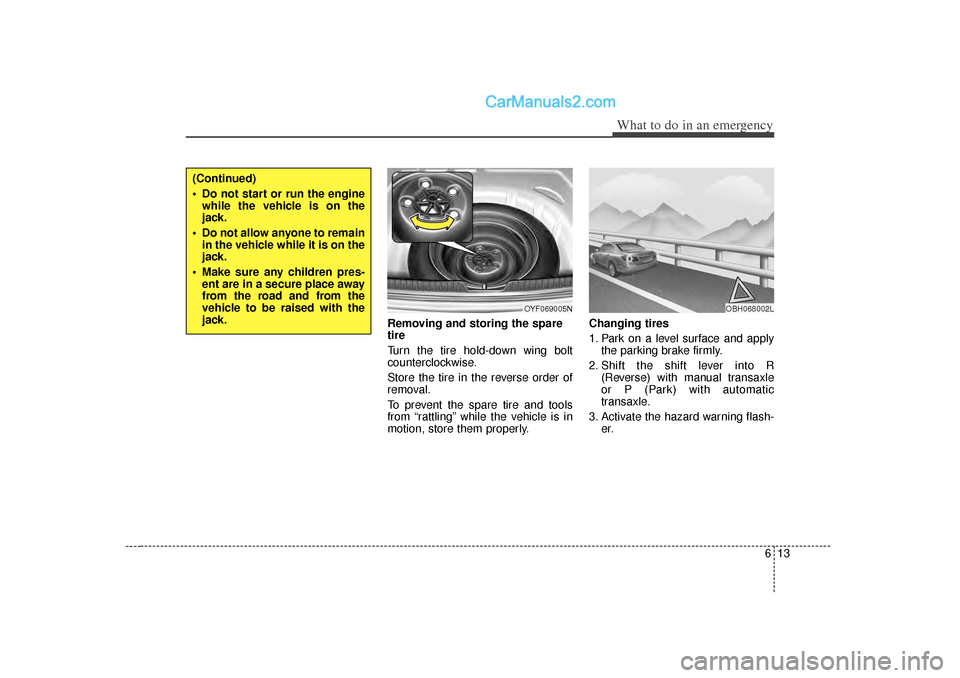
613
What to do in an emergency
Removing and storing the spare
tire
Turn the tire hold-down wing bolt
counterclockwise.
Store the tire in the reverse order of
removal.
To prevent the spare tire and tools
from “rattling” while the vehicle is in
motion, store them properly.Changing tires
1. Park on a level surface and apply
the parking brake firmly.
2. Shift the shift lever into R (Reverse) with manual transaxle
or P (Park) with automatic
transaxle.
3. Activate the hazard warning flash- er.
OYF069005N
(Continued)
Do not start or run the enginewhile the vehicle is on the
jack.
Do not allow anyone to remain in the vehicle while it is on the
jack.
Make sure any children pres- ent are in a secure place away
from the road and from the
vehicle to be raised with the
jack.
OBH068002L
Page 404 of 411
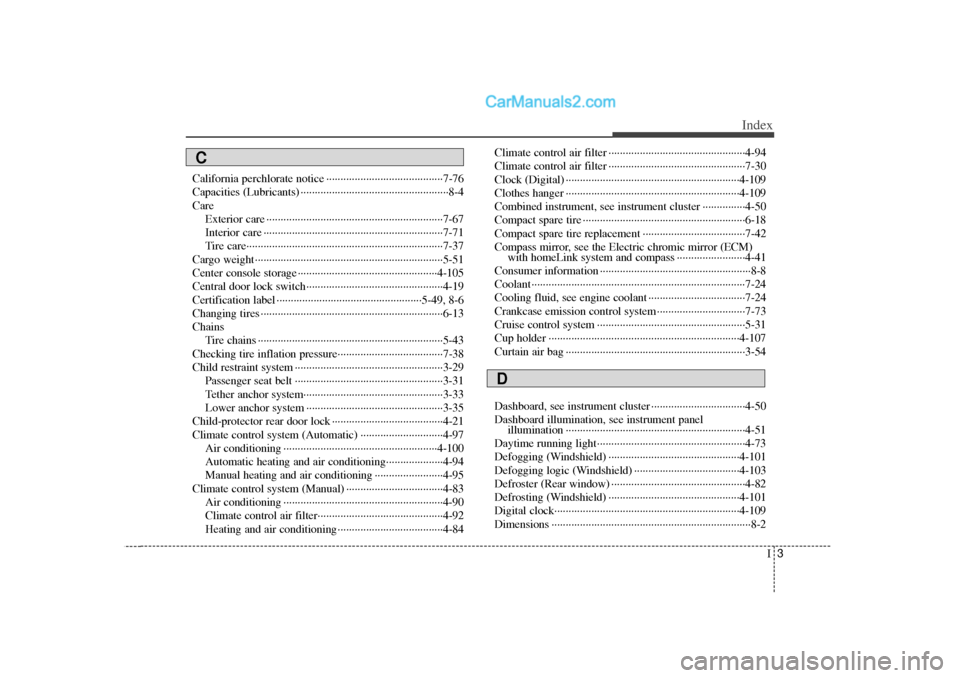
I3
Index
California perchlorate notice ··················\
··················\
·····7-76
Capacities (Lubricants) ··················\
··················\
················8-4
CareExterior care ··················\
··················\
··················\
········7-67
Interior care ··················\
··················\
··················\
·········7-71
Tire care··················\
··················\
··················\
···············7-37
Cargo weight ··················\
··················\
··················\
············5-51
Center console storage ··················\
··················\
·············4-105
Central door lock switch··················\
··················\
············4-19
Certification label ··················\
··················\
···············5-49, 8-6
Changing tires ··················\
··················\
··················\
··········6-13
Chains Tire chains ··················\
··················\
··················\
···········5-43
Checking tire inflation pressure··················\
··················\
·7-38
Child restraint system ··················\
··················\
················3-29 Passenger seat belt ··················\
··················\
················3-31
Tether anchor system··················\
··················\
·············3-33
Lower anchor system ··················\
··················\
············3-35
Child-protector rear door lock ··················\
··················\
···4-21
Climate control system (Automatic) ··················\
···········4-97 Air conditioning ··················\
··················\
··················\
4-100
Automatic heating and air conditioning··················\
··4-94
Manual heating and air conditioning ··················\
······4-95
Climate control system (Manual) ··················\
················4-83 Air conditioning ··················\
··················\
··················\
··4-90
Climate control air filter··················\
··················\
········4-92
Heating and air conditioning··················\
··················\
·4-84 Climate control air filter ··················\
··················\
············4-94
Climate control air filter ··················\
··················\
············7-30
Clock (Digital) ··················\
··················\
··················\
·······4-109
Clothes hanger ··················\
··················\
··················\
·······4-109
Combined instrument, see instrument cluster ···············4-50
Compact spare tire ··················\
··················\
··················\
···6-18
Compact spare tire replacement ··················\
··················\
7-42
Compass mirror, see the Electric chromic mirror (ECM)
with homeLink system and compass ··················\
······4-41
Consumer information ··················\
··················\
·················8-8
Coolant ··················\
··················\
··················\
··················\
···7-24
Cooling fluid, see engine coolant ··················\
················7-24
Crankcase emission control system ··················\
·············7-73
Cruise control system ··················\
··················\
················5-31
Cup holder ··················\
··················\
··················\
·············4-107
Curtain air bag ··················\
··················\
··················\
·········3-54
Dashboard, see instrument cluster ··················\
···············4-50
Dashboard illumination, see instrument panel illumination ··················\
··················\
··················\
·········4-51
Daytime running light··················\
··················\
················4-73
Defogging (Windshield) ··················\
··················\
··········4-101
Defogging logic (Windshield) ··················\
··················\
·4-103
Defroster (Rear window) ··················\
··················\
···········4-82
Defrosting (Windshield) ··················\
··················\
··········4-101
Digital clock··················\
··················\
··················\
···········4-109
Dimensions ··················\
··················\
··················\
················8-2C
D